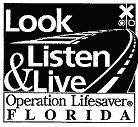TECHNICAL ASSISTANCE NOTE
No. T-03-10
Contact:
Kay Kanupp
Bureau of School Business Services
€
School Transportation Management Section
€
Department of Education
(850)
488-4405
Charlie Crist, Commissioner
SC 278-4405
DATE:
December 19, 2002
TO:
?
Superintendents
Transportation Directors
FROM:
?
Ronnie H. McCallister, Program Director
Operations, Audits, and Safety Subsection
SUBJECT:
New Best Practice for Railroad-Grade Crossing Procedures
The Florida Association for Pupil Transportation (FAPT) Operations Committee has approved a
new best practice for railroad-grade crossing procedures.
The Department of Education and
Florida Operation Lifesaver (OL) encourage you to provide a copy of this procedure to each
school bus driver.
Section 316.159, Florida Statutes,
states, in part, “(1) The driver of any motor vehicle carrying
passengers for hire, excluding taxicabs, of any school bus carrying any school child, or of any
vehicle carrying explosive substances or flammable liquids as a cargo or part of a cargo, before
crossing at grade any track or tracks of a railroad, shall stop such vehicle within 50 feet but not
less than 15 feet from the nearest rail of the ra
ilroad and, while so stopped, shall listen and look
in both directions along the track for any approaching train, and for signals indicating the
approach of a train, except as hereinafter provided, and shall not proceed until he or she can do
so safely. After stopping as required herein and proceeding when it is safe to do so, the driver of
any such vehicle shall cross only in a gear of the vehicle so that there will be no necessity for
changing gears while traversing the crossing, and the driver shall not shift gears while crossing
the track or tracks.
(2) No stop need be made at any such crossing where a police officer, a traffic control signal, or a
sign directs traffic to proceed
.
However, any school bus carrying any school child shall be
required to stop unless directed to proceed by a police officer.”
The law is very clear that every school bus carrying school children must stop at every
railroad-grade crossing!
TAN #T-03-10
December 19, 2002
Page Two
NEW BEST PRACTICE
�
Deactivate the pupil warning (student loading lights) master switch at 150 feet from the crossing
and activate 4-way hazard flashers.
�
Turn off all noise-making devices or activate noise abatement switch (if equipped) and quiet
students.
�
Open the driver window completely.
�
Bring the bus to a stop at least 15 feet from the nearest rail and not more than 50 feet.
�
Apply the parking brake.
�
Shift to neutral.
�
Fully open the service door.
�
Listen and look in both directions for approaching trains.
�
When it is clear to do so, shift to drive, release the park brake, and close the service door.
Never
allow the bus to sit in neutral without the parking brake being applied.
�
The noise abatement switch (if equipped) may be released at this time.
�
Look once more in both directions.
�
Continue across the tracks without hesitation until the rear of the bus is clear of the nearest rail.
�
Deactivate the 4-way hazard flashers and reactivate the pupil warning (student loading lights)
master switch.
We understand that your school district’s railroad procedure may differ from this procedure,
approved by the Florida Association for Pupil Transportation Operations Committee. Due to the
importance of standardized statewide procedures in this important safety area, however, we
strongly urge you to consider adopting this FAPT/DOE-recommended procedure locally. Drivers
should be trained and updated accordingly.
Operation Lifesaver has also requested that the Department send the enclosed safety brochure
with their railway-grade crossing procedure to every district for distribution to every driver. You
will note that OL’s procedure, while more concise, is consistent with the new best practice
above.
We believe these procedures will augment and reinforce the substantial railroad-grade crossing
training that all Florida public school bus drivers have already received. Our goal is to eliminate
all crashes involving school buses and trains.
In calendar year 2001, there were 107 grade-
crossing crashes in Florida involving all types of motor vehicles with 11 fatalities and 33 injuries.
Two of these crashes involved school buses, and there were
NO
fatalities.
If you have any questions or concerns please email Kay Kanupp at kay.kanupp@fldoe.org or call her at
(850) 488-4405.
RHM/kk
Attachment
cc:
?
Billy
Parker
Cathy Wooley-Brown
Jennifer Rippner
J.C. Bowman
IT’S THE LAW!
As a professional school bus driver, you need to be familiar with Motor Vehicle
Law 316.159. This law states that, “The driver of any bus carrying any school
child, before crossing at grade any track or tracks,
shall
stop such vehicle within
50 feet but not less than 15 feet from the nearest rail of the railroad…”
Upon approaching railroad tracks, the bus driver should activate the 4-way hazard
flashers to communicate the fact that the bus will be stopping.
AFTER
BRINGING THE BUS TO A COMPLETE STOP
(not less than 15 feet or more
than 50 feet from the rail nearest the front of the bus) the driver
shall:
�
Apply the parking brake
€
�
Shift the bus into neutral
€
�
Fully open the service door
€
�
Fully open the driver window
€
�
Look and listen in both directions for approaching trains
€
�
Close the service door before proceeding across the railroad tracks
€
PLEASE DON’T JEOPARDIZE YOUR JOB, LIFE, OR THE
LIVES OF THE CHILDREN THAT YOU ARE TRANSPORTING!
If any school bus driver is observed failing to stop at a highway-rail crossing, he
or she will immediately be reported to their Transportation Director.


